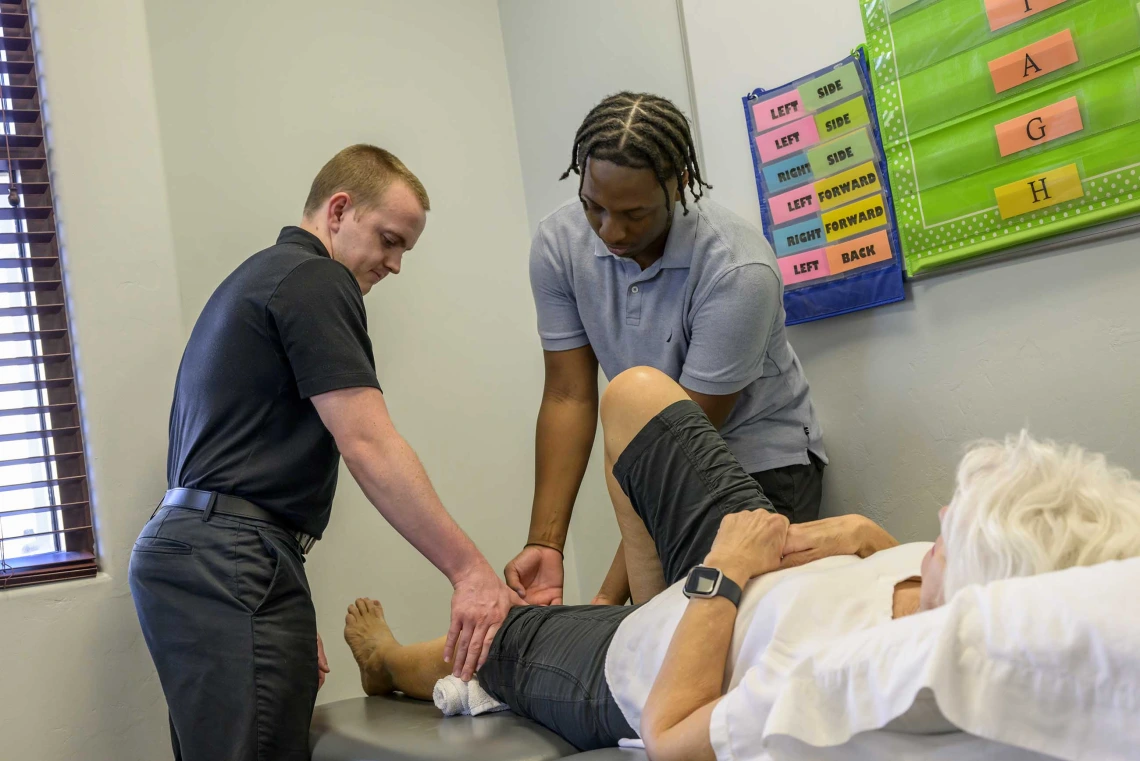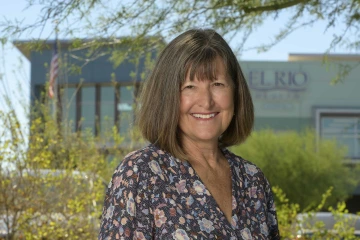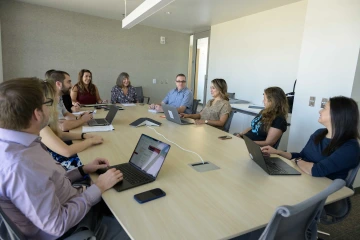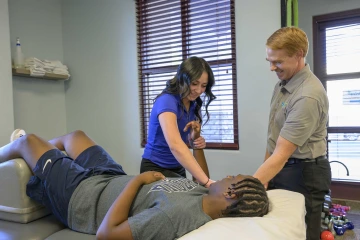Bridging health care education and workforce needs
The College of Health Sciences is building a large network of clinical training partners for students while addressing the state’s health care workforce shortage.

Lukas Barker, DPT, (left) works at Strive Physical Therapy in Tucson, a clinical partner for the College of Health Sciences’ developing PT program, which is expected to welcome its first class in fall 2025.
Photo by Kris Hanning, U of A Health Sciences Office of Communications
Arizona’s workforce shortages have created a pressing need for more health care providers, particularly in rural areas. Shortages for nurses and primary care doctors are well-documented, but there are growing needs for specialized providers such as physical therapists in these areas, too. The Center for Rural Health at the University of Arizona Mel and Enid Zuckerman College of Public Health reports that 93% of all physical therapists work in urban areas. This leaves rural counties, such as Graham County, well below the state and national averages of providers per 10,000 residents.

Nancy Johnson, PhD, a former CEO at El Rio Health, served as a faculty member in both the U of A College of Nursing and College of Medicine – Tucson before taking on her current role at the U of A College of Health Sciences.
Photo by Kris Hanning, U of A Health Sciences Office of Communications
At the University of Arizona College of Health Sciences, faculty and staff are focused on developing clinical partnerships that connect students with the communities that need them most.
Throughout the state, organizations take different approaches to filling the health care gap. At Mount Graham Hospital in Graham County, which is already a clinical rotation site for students at the U of A College of Medicine – Tucson, the hospital identifies local high school students interested in health care careers and offers them summer jobs and mentorship.
“Mount Graham hospital identifies students interested in health-related careers and keeps them connected to the community, increasing the likelihood they return after graduation,” said Nancy Johnson, PhD, RN, director of clinical partnerships at the U of A College of Health Sciences. “I’d like to see more of these pipeline models with our students across the state to expand our future health care providers who remain in Arizona.”
Clinical partnerships provide students with hands-on experience in diverse clinical settings. These educational experiences build students’ diagnostic and treatment skills as health care professionals while connecting them to the communities where they train. The real-world experiences help students form lasting relationships with local health systems, increasing the likelihood they will stay and work in those communities after graduation.
“The opportunity to create meaningful clinical partnerships that focus on bidirectional pathways for future health care providers is one of the most important aspects of success for our college,” said Kevin Lohenry, PhD, PA-C, interim dean of the College of Health Sciences. “Taking time to understand the unique needs in their communities allows us to be thoughtful about how we may position the college to support their needs while building strong relationships for our combined future.”
Growing a network of clinical opportunities

Communication and collaboration with faculty and staff members from the six Health Sciences colleges is critical to Johnson’s goal of building a robust clinical partnership network to benefit students.
Photo by Kris Hanning, U of A Health Sciences Office of Communications
At the U of A College of Health Sciences, Johnson is focused on closing the gap between academic training and real-world health care delivery by building a robust network of clinical placement opportunities in diverse communities.
Johnson has a deeply rooted commitment to improving health care access, shaped by decades of dedicated service to Southern Arizona communities. She successfully managed programs that integrated care for underserved populations at two of Arizona’s largest health care organizations.
For 15 years, she served in various roles for Tucson Medical Center, including building community health programs, acquiring medical practices and working in rural communities, before becoming the Chief Executive Officer at El Rio Health, one of the nation’s largest federally qualified health centers. She has also served on the faculty at the U of A College of Nursing and the College of Medicine – Tucson.
This work gave her a deep understanding of the challenges faced by vulnerable communities. It also honed her ability to connect academic research with real-world clinical practice.
“We don’t have enough health care professionals to care for all of us, especially with the growing population and the need for care,” Johnson said. “We are building more partnerships with both urban and rural hospitals and practices, as well as Arizona’s community health centers, who all share a priority around needed workforce growth. Thinking strategically about Arizona’s workforce in collaboration with our many partners will enhance students’ training and hopefully encourage students to remain in Arizona to practice. We need to make sure students have great clinical experiences as well as support the clinical settings with which we partner, who daily address the real challenges in patient care.”
Building Arizona’s future health care workforce
One of Johnson’s initiatives is to further enhance collaboration between the U of A Health Sciences’ six colleges. Historically, clinical placements rarely cross health disciplines such as medicine, nursing and pharmacy. One of the major challenges is streamlining educational affiliation agreements in order to unify systems.

(From left) Esther Torres and Daniel Mulumba, undergraduate students who hope to pursue careers in physical therapy, demonstrate what clinical training might look like with Lukas Barker, DPT, over of Strive Physical Therapy.
Photo by Kris Hanning, U of A Health Sciences Office of Communications
Johnson is advocating for a system that tracks clinical opportunities across programs, including the new College of Health Sciences physical therapy and physician assistant programs, ensuring that all students benefit from increased access to clinical sites. Promoting interdisciplinary learning also allows students to collaborate with peers from other health disciplines, which they will do after graduation as part of a health care team.
The clinical partnerships Johnson is developing extend outside of the university to larger urban hospitals, including Tucson Medical Center, where she helped develop a clinical scholar program with the College of Nursing to support additional clinical faculty from the TMC nursing staff. This program not only supports students, but also helps hospitals build the future nursing workforce.
“When our students rotate through TMC, they get to know the hospital, the staff and the systems,” Johnson said. “After they graduate, they are ready for entry into practice.”
Johnson is helping ensure that Arizona will have health care providers for the future by developing partnerships that connect students with the communities that need them most; however, her vision extends beyond simply placing students in clinical sites. Johnson is focused on creating a sustainable system that supports both students and the communities they serve.
She has identified more than 100 potential new clinical spots within a two-hour radius of Tucson. Many of them are in medically underserved areas such as Wilcox and Safford, where a single physician may serve an entire community. These placements provide students with hands-on experience in high-demand environments while addressing local workforce shortages.
“When we can actively partner with our community health care clinicians and organizations, students’ experiences are enhanced and commitment to practicing in Arizona may grow,” she said.
Experts
Nancy Johnson, PhD, RN
Director of Clinical Partnerships, College of Health Sciences
Kevin Lohenry, PhD, PA-C
Interim Dean, College of Health Sciences
Assistant Vice President, Interprofessional Education, U of A Health Sciences
Contact
Blair Willis
U of A Health Sciences Office of Communications
520-419-2979, bmw23@arizona.edu

